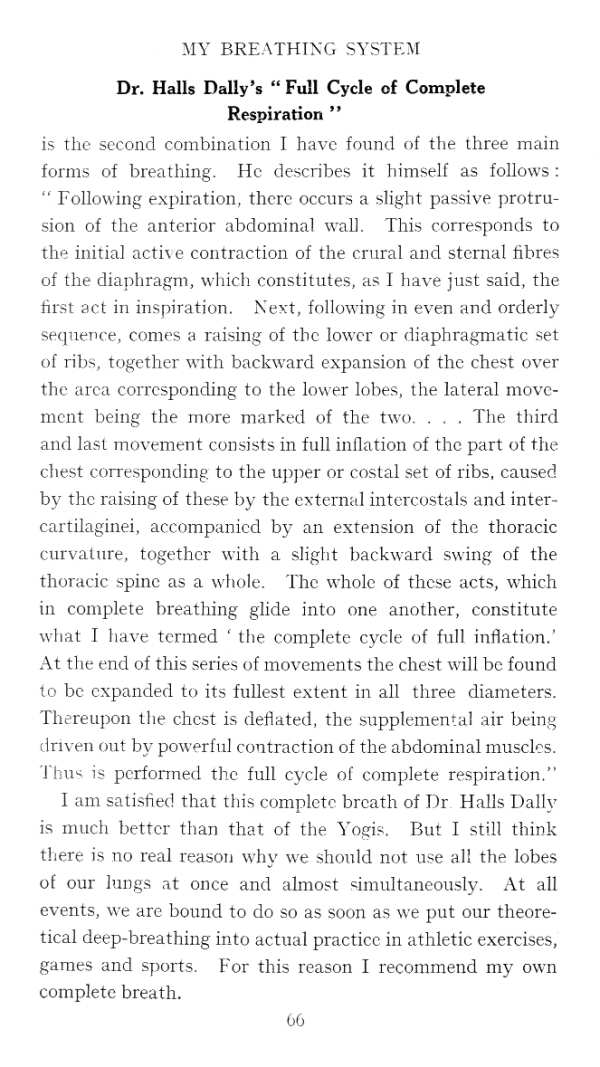mbs 066

MY BREATHING SYSTEM
Dr. Halls Dally’s “ Fuli Cycle of Complete Respiration ”
is the second combination I havc found of the three rnain forms of breathing. Hc describes it himself as follows: “ Following expiration, thcrc occurs a slight passive protru-sion of the anterior abdominal waU. This corresponds to the initial acti\e contraction of the crural and sternal fibres of the diapliragm, which conslitutes, as 1 have just said, the first act in inspiration. Next, following in even and orderly secptence, comes a raising of the lowcr or diaphragmatic set of ribs, together with baekward expansion of the chest over the arca corrcsponding to the lower lobes, the lateral movc-ment being the morę marked of the two. . . . Tlie third and łasi movement consists in fuli inflation of the part of the chest corresponding to the upper or costal set of ribs, caused by the raising of these by the external intercostals and inter-cartilaginei, accompanicd by an extension of the thoracic curvature, together with a slight baekward swing of the thoracic spine as a whole. The whole of these acts, which in complete breathing glide into one another, constitute what I have termed ' the complete cycle of fuli inflation.1 At the end of this senes of movements the chest will be found to be cxpanded to its fullest extent in all three diameters. Thereupon the chest is deflated, the supplemental air being dnven out by powerful contraction of the abdominal musclcs.
I hm i# perfonned the fuli cycle of complete respiration.” I am satisfied that this complete brcath of Dr Halls Daily is much better than that of the Yogis. But I still think there is no real reason why we should not tise all the lobes of our lungs at once and almost simultaneously. At all events, we are bound to do so as soon as we put our theore-tical deep-breathing into actual practicc in athletic exercises, games and sports. For this reason I recommend my own complete breath.
oO
Wyszukiwarka
Podobne podstrony:
mbs 106 MY BREATHING SYSTEM almost unknown and where tlie influence of fashion is so powerful. Of co
mbs 046 MY BREATHING SYSTEM Further, on p. 13, Dr. Hulbert vrites : “ By this mcthod of breathing wh
52396 mbs 043 MY BREATHING SYSTEM when we spend our time in crowded halls in poisonous air, or are f
mbs 005 MY BREATHING SYSTEM BYLIEUT. J. P. MI LLER, K.D. Author of My System," " My System
mbs 011 MY BREATHING SYSTEM and violent palpitatiops. Sncli an overstrained licart could never last
mbs 014 MY BREATHING SYSTEM slow, regular respiration, even during the hardcst and most protracted e
mbs 022 MY BREATHING SYSTEM against the invasion and throw ol f thc gernis, which arc ejected with t
mbs 027 MY BREATHING SYSTEM sucked in. For persons who lind it very difficult to acquire tłiis contr
mbs 035 MY BREATHING SYSTEM How to Expand and Contract the Thorax to its fullest Extent The thoracic
mbs 038 MY BREATHING SYSTEM scientiiically established this fact. He said, in a recent lecture : &qu
więcej podobnych podstron